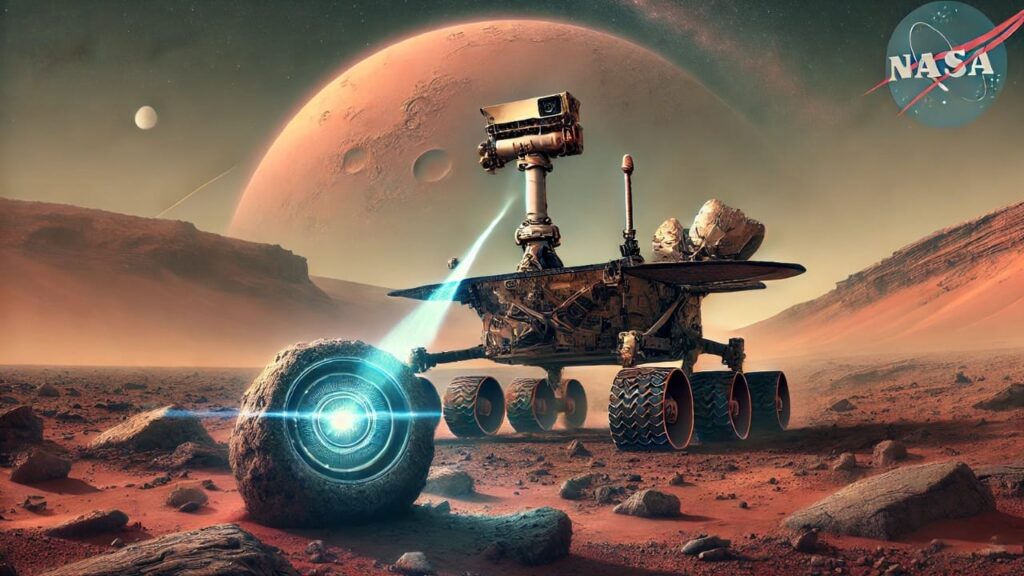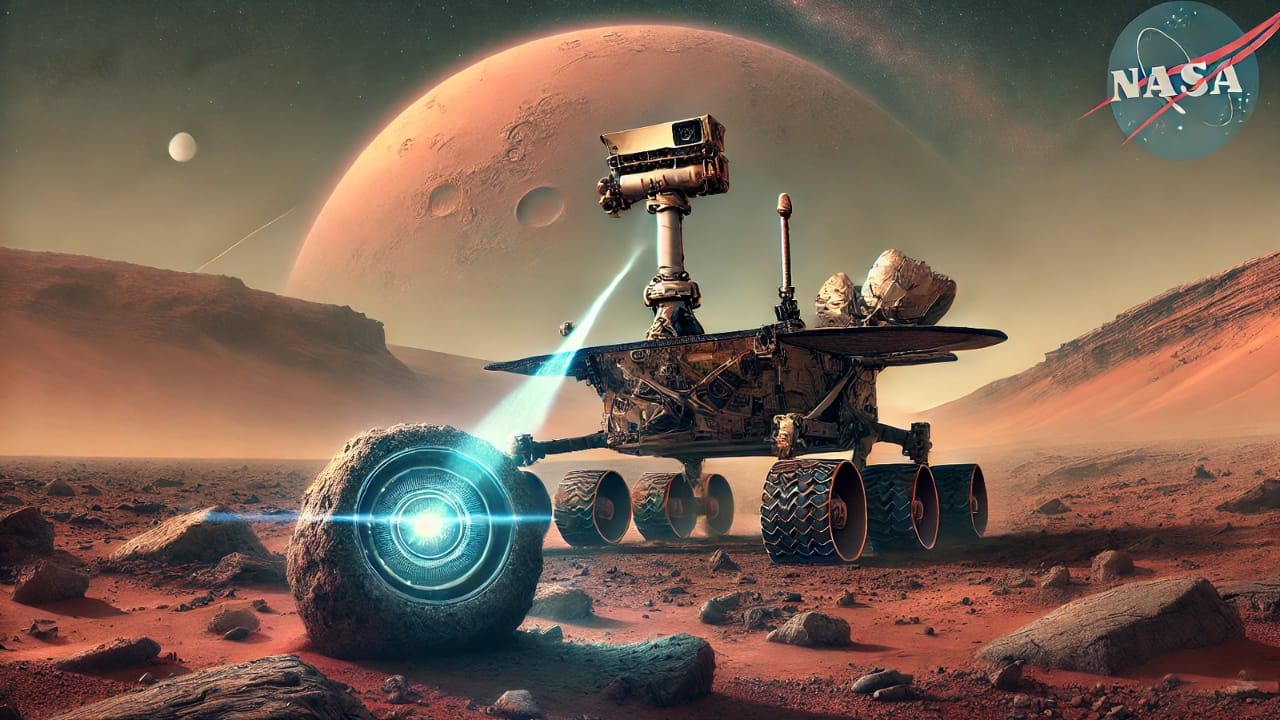NASA Perseverance rover, SHERLOC instrument revival ,Mars exploration,Ancient microbial life on Mars ,Jezero Crater mission ,Mars rover SHERLOC ,NASA Jet Propulsion Laborator, Mars 2020 mission ,Astrobiology Mars ,Martian rock analysis
Discover how NASA’s Perseverance team successfully revived the SHERLOC instrument after six months of intensive effort. Learn about the crucial role of SHERLOC in searching for signs of ancient microbial life on Mars, the challenges faced by the team, and the innovative solutions that brought this vital instrument back online.

Detective Work Enables Perseverance Team to Revive SHERLOC Instrument
After six months of relentless effort, NASA’s Perseverance team has successfully revived the SHERLOC (Scanning Habitable Environments with Raman & Luminescence for Organics and Chemicals) instrument, which is pivotal in the mission’s search for signs of ancient microbial life on Mars. The instrument, which had been offline since January, recently analyzed a rock target using its spectrometer and camera, marking a significant milestone in the mission’s ongoing efforts.
The Vital Role of SHERLOC
SHERLOC, mounted on Perseverance’s robotic arm, utilizes two cameras and a laser spectrometer to detect organic compounds and minerals in rocks that may have been altered in watery environments. This capability is crucial for identifying signs of past microbial life on Mars. The instrument encountered a major issue on January 6 when a movable lens cover, designed to protect its spectrometer and one of its cameras from dust, froze in a position that hindered data collection. The SHERLOC team diagnosed the problem as a malfunction in a small motor responsible for moving the protective lens cover and adjusting the focus for both the spectrometer and the Autofocus and Context Imager (ACI) camera.
The Revival Process
The SHERLOC team at NASA’s Jet Propulsion Laboratory (JPL) in Southern California embarked on a meticulous evaluation process to address the malfunction. They tested potential solutions on a duplicate SHERLOC instrument at JPL, which involved a series of diagnostic and troubleshooting steps. These included heating the lens cover’s motor, rotating the SHERLOC instrument to different orientations using the rover’s robotic arm, rocking the mechanism to dislodge any debris, and even using the rover’s percussive drill to jostle the lens cover loose.
On March 3, imagery from Perseverance indicated that the ACI cover had opened more than 180 degrees, clearing the imager’s field of view. This partial success was a significant breakthrough. As Kyle Uckert, SHERLOC’s deputy principal investigator at JPL, stated, “With the cover out of the way, a line of sight for the spectrometer and camera was established. We were halfway there.”
Achieving Full Functionality
Despite this progress, the SHERLOC team still faced the challenge of focusing the instrument on its targets. Without the ability to adjust the focus of the instrument’s optics, SHERLOC images would be blurry and the spectral signal weak. The team devised a strategy to use the rover’s robotic arm to make precise adjustments in the distance between SHERLOC and its target to achieve optimal image resolution. They commanded SHERLOC to take pictures of its calibration target, enabling them to fine-tune this approach.
“The rover’s robotic arm is amazing. It can be commanded in small, quarter-millimeter steps to help us evaluate SHERLOC’s new focus position, and it can place SHERLOC with high accuracy on a target,” said Uckert. After extensive testing on both Earth and Mars, they determined that the best distance for the robotic arm to place SHERLOC is about 40 millimeters (1.58 inches). This positioning ensures that the data collected is as high quality as before the malfunction.
On May 20, the team received confirmation that the ACI was accurately positioned on a Martian rock target. The final verification on June 17 confirmed that the spectrometer was also functional, marking the complete restoration of SHERLOC’s capabilities.
Perseverance’s Ongoing Mission
With SHERLOC operational, Perseverance continues its exploration of the “Margin Unit,” an area along the inside of Jezero Crater’s rim. This region is of particular interest because it may contain carbonate and olivine deposits, which could provide insights into the planet’s past environments. On Earth, carbonates typically form in shallow freshwater or alkaline lakes, suggesting a similar historical environment on Mars over 3 billion years ago.
A key objective of Perseverance’s mission is astrobiology, including the collection and caching of samples that may contain signs of ancient microbial life. These samples will be critical for future missions, in cooperation with the European Space Agency (ESA), to retrieve and return to Earth for detailed analysis. This mission is part of NASA’s broader Moon to Mars exploration approach, which includes the Artemis missions to the Moon that will lay the groundwork for human exploration of Mars.
The Broader Impact
The successful revival of SHERLOC underscores the resilience and ingenuity of the Perseverance team. As Art Thompson, Perseverance’s project manager at JPL, noted, “Mars is hard, and bringing instruments back from the brink is even harder. But the team never gave up. With SHERLOC back online, we’re continuing our explorations and sample collection with a full complement of science instruments.”
The Perseverance rover’s mission is a testament to human perseverance and the relentless pursuit of knowledge. The lessons learned from troubleshooting and reviving SHERLOC will not only benefit future Mars missions but also enhance our understanding of maintaining and repairing complex instruments in remote and harsh environments.
Future Prospects
Looking ahead, the Perseverance rover will continue to explore and collect samples from Mars, providing invaluable data that will inform future missions and scientific understanding. The collaboration between NASA and ESA to return Martian samples to Earth represents a significant step forward in planetary science and astrobiology.
In addition to its scientific goals, Perseverance’s mission contributes to the broader objective of preparing for human exploration of Mars. The technologies and strategies developed and tested during this mission will pave the way for future human missions, bringing us closer to the day when humans set foot on the Red Planet.
Conclusion
The revival of the SHERLOC instrument after six months of intensive detective work by the Perseverance team is a remarkable achievement. It highlights the importance of perseverance, innovation, and teamwork in overcoming challenges and advancing our exploration of Mars. As SHERLOC resumes its critical role in the mission, the prospects for discovering signs of ancient microbial life on Mars remain as promising as ever, marking another step forward in our quest to understand the mysteries of the Red Planet.
Read More
- The ChatGPT is an artificial intelligence language model developed by OpenAI for
- NASA Selects SpaceX for ISS US Deorbit Vehicle to Ensure Safe Transition in Low Earth
- NASA Perseverance Rover Discovers Unusually Light-Colored Boulder on Mars:
- NASA Selects Lockheed Martin for $2.27 Billion GeoXO Satellite Program










